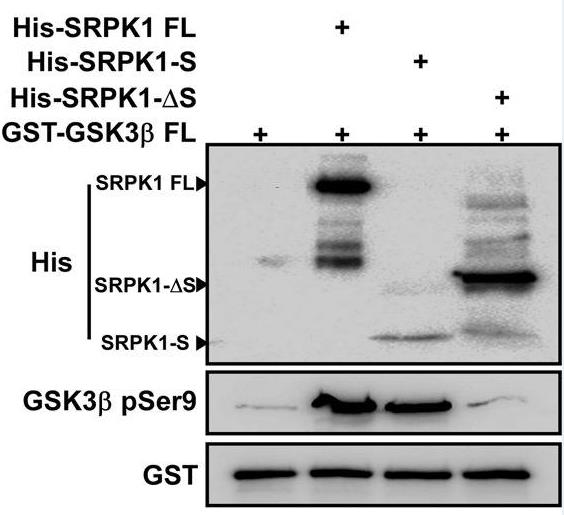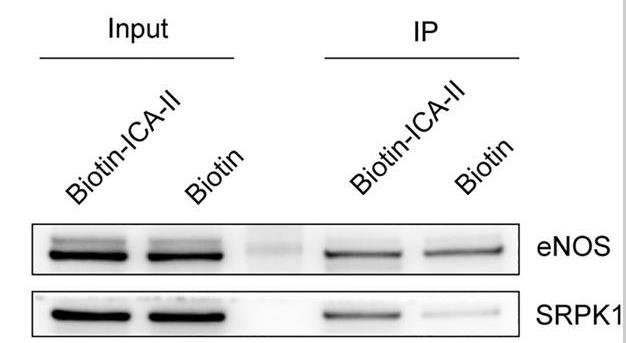SRPK1
-
Official Full Name
SRSF protein kinase 1 -
Overview
This gene encodes a serine/arginine protein kinase specific for the SR (serine/arginine-rich domain) family of splicing factors. The protein localizes to the nucleus and the cytoplasm. It is thought to play a role in regulation of both constitutive and alternative splicing by regulating intracellular localization of splicing factors. Alternative splicing of this gene results in multiple transcript variants. Additional alternatively spliced transcript variants have been described for this gene, but their full length nature have not been determined. -
Synonyms
SRPK1;SRSF protein kinase 1;SFRS protein kinase 1;serine/arginine rich splicing factor kinase 1;SFRSK1;SR protein kinase 1;SR-protein-specific kinase 1;serine/threonine-protein kinase SRPK1;serine/arginine-rich splicing factor kinase 1
Recombinant Proteins
- Human
- Mouse
- Insect Cell
- Insect (sf21)
- E.coli
- Mammalian Cell
- Sf9 Insect Cell
- HEK293
- His&GST
- Flag
- GST
- His
- Non
- His&Fc&Avi
Background
What is SRPK1 protein?
SRPK1 gene (SRSF protein kinase 1) is a protein coding gene which situated on the short arm of chromosome 6 at locus 6p21. It is primarily known for its role in the regulation of alternative splicing by phosphorylating splicing factors containing arginine/serine-rich domains, known as SR domains. This kinase is involved in the phosphorylation of SR splicing factors and the control of their intranuclear distribution, which in turn affects the splicing process. SRPK1's activity is modulated by various mechanisms, including post-translational modifications and interactions with other cellular components. It is also influenced by its localization within the cell, its phosphorylation state, and its interaction with molecular chaperones. The SRPK1 protein is consisted of 655 amino acids and SRPK1 molecular weight is approximately 74.3 kDa.
What is the function of SRPK1 protein?
SRPK1 phosphorylates serine residues within arginine/serine-rich domains (RS domains) of SR proteins, which are essential for the splicing process. SRPK1 is involved in controlling the distribution of splicing factors within the nucleus, affecting the assembly of spliceosomes and the efficiency of splicing reactions. By regulating alternative splicing, SRPK1 can influence the production of different protein isoforms from the same gene, thereby impacting a wide range of cellular functions and pathways. SRPK1 may also play a role in other cellular activities such as chromatin reorganization in somatic and sperm cells and cell cycle progression.

Fig1. SRPK1 overexpression deregulates alternative splicing and promotes cancer through distinct oncogenic processes. (Ilias P Nikas, 2019)
SRPK1 Related Signaling Pathway
SRPK1 has been shown to be involved in the SRPK1-Akt-eNOS pathway, which is implicated in the regulation of endothelial cell function and nitric oxide production, important for vascular health. SRPK1 is also connected to the PI3K/Akt pathway, NF-κB Signaling, TGF-Beta Pathway, Wnt/β-Catenin Pathway, JAK-2/STAT-3 Pathway and p53 Pathway. In addition, SRPK1 has been reported to play a role in the regulation of hepatitis B virus (HBV) replication.
SRPK1 Related Diseases
Increased expression of SRPK1 is associated with EGFR-TKI (epidermal growth factor receptor tyrosine kinase inhibitor) resistance in non-small cell lung cancer patients and may promote resistance by enhancing the autophosphorylation of GSK3β Ser9 independent of its kinase activity. SRPK1 is upregulated in patients with peripheral T-cell lymphoma and is associated with poorer survival, and its inhibition inhibits cell proliferation and induces apoptosis. Other associated diseases include osteosarcoma, Denys-Drash syndrome, SARS-CoV-2 infection, and abnormal expression in a variety of tumors, including lung, breast, ovarian, stomach, liver, and hematological tumors.
Bioapplications of SRPK1
SRPK1 expression levels are positively correlated with tumor aggressiveness and metastasis, making it a potential target for tumor therapy. Several drugs targeting SRPK1 have entered clinical studies, such as SRPK1/2 inhibitors SRPIN340 and SPHINX31, which influence tumor cell growth and survival by regulating SRPK1 activity. Targeting SRPK1 using RNA interference technology (siRNA) or CRISPR-Cas9 gene editing technology as a gene therapy means may be effective in treating certain types of cancer. The study found that specific micrornas (such as miRNA-9, miRNA-1296, miRNA-155, etc.) can regulate the expression of SRPK1, which provides a new idea for the treatment through micrornas intervention. Acetylation of SRPK1, particularly by TIP60-dependent means, may influence splicing events and, in turn, the sensitivity of tumor cells to chemotherapy agents.
Case Study
Case Study 1: Jing-Qiang Huang, 2023
Serine-arginine protein kinase 1 (SRPK1) is a key oncoprotein in the EGFR/AKT pathway that participates in tumorigenesis. Both in vitro and in vivo assays suggested that SRPK1 reduced the ability of gefitinib to induce apoptosis in sensitive NSCLC cells independently of its kinase activity. Moreover, SRPK1 facilitated binding between LEF1, β-catenin and the EGFR promoter region to increase EGFR expression and promote the accumulation and phosphorylation of membrane EGFR. Furthermore, researchers verified that the SRPK1 spacer domain bound to GSK3β and enhanced its autophosphorylation at Ser9 to activate the Wnt pathway, thereby promoting the expression of Wnt target genes such as Bcl-X.

Fig1. Co-IP analysis of the interaction between SRPK1 and GSK3β.

Fig2. Kinase activity assay of the phosphorylation relationship between SRPK1 fragments and GSK3β in vitro.
Case Study 2: Yang-Yang Gu, 2022
Alternative splicing participates in the regulation of cellular and tissular homeostasis and is highly regulated by serine-arginine protein kinase (SRPK1). The purpose of this study is to explore the role of SRPK1 in the biology of endothelial cells and the underlying mechanism of ICA Ⅱ on palmitic acid (PA) induced endothelial dysfunction. Endothelial dysfunction was induced using PA in human umbilical vein endothelial cells (HUVECs). The expression and phosphorylation of related proteins in the SRPK1-Akt-eNOS signaling pathway were detected by Western Blot. Interaction between ICA Ⅱ and SRPK1 was demonstrated by a biotinylated protein interaction pull-down assay. The data showed that the expressions of eNOS, Akt, and SRPK1 were down-regulated in the endothelial dysfunction stimulated by PA. Biotinylated protein interaction pull-down assay revealed that ICA Ⅱ could be directly bound with SRPK1. On the other hand, ICA Ⅱ could attenuate the PA-induced endothelial dysfunction and restore cell viability through the SRPK1-Akt-eNOS pathway.

Fig3. SRPK1 is down-regulated in endothelial dysfunction induced by PA.

Fig4. Lysates prepared from HUVECs were examined for ICA Ⅱ binding to SRPK1 and eNOS using pull-down assay.
Quality Guarantee
Involved Pathway
SRPK1 involved in several pathways and played different roles in them. We selected most pathways SRPK1 participated on our site, such as Herpes simplex infection, which may be useful for your reference. Also, other proteins which involved in the same pathway with SRPK1 were listed below. Creative BioMart supplied nearly all the proteins listed, you can search them on our site.
| Pathway Name | Pathway Related Protein |
|---|---|
| Herpes simplex infection | TRAF2,MHC2DCB,HNRPKL,TAP2,EEF1DB,TRAF6,HLA-DRA,RNASEL,MAPK8A,C3A.1 |
Protein Function
SRPK1 has several biochemical functions, for example, ATP binding,magnesium ion binding,poly(A) RNA binding. Some of the functions are cooperated with other proteins, some of the functions could acted by SRPK1 itself. We selected most functions SRPK1 had, and list some proteins which have the same functions with SRPK1. You can find most of the proteins on our site.
| Function | Related Protein |
|---|---|
| protein kinase activity | LTK,ARAF,RPS6KB2,GSK3AB,SOX9,RPS6KB1,PRPF4B,STK25B,RIPK1,SGK2B |
| protein serine/threonine kinase activity | CAMK2D2,ACVR2A,ICK,CDC42BPA,CDC42BPB,CSNK1G2,PIK3CG,CSNK2A1,STK19,OBSCN |
| poly(A) RNA binding | RBMS1,RBM4B,MTIF2,RPL7A,RPL26,ZC3HAV1,EIF2S1,NUDT16L1,EIF2S2,PKN2 |
| magnesium ion binding | LHPP,ALPP,SNCA,ATP11C,DUT,SPHK1,IMPA1,TSSK1,OPA1,RPS6KA3 |
| protein binding | P2RY1,ANKRD10,NEUROG1,CLEC4G,WBP2NL,WFDC9,EFCAB11,pab1,NF2,LRRC8C |
| ATP binding | RRM1,KIF21A,MAP2K2B,SLFN5,RTEL1,CDK10,PNCK,HIPK1,MAPK1,TRIP13 |
Interacting Protein
SRPK1 has direct interactions with proteins and molecules. Those interactions were detected by several methods such as yeast two hybrid, co-IP, pull-down and so on. We selected proteins and molecules interacted with SRPK1 here. Most of them are supplied by our site. Hope this information will be useful for your research of SRPK1.
SRSF1;RNPS1;a7y3z3_hpv16;TP53;YWHAB;YWHAG;PRPF38A;DGCR8
Resources
Related Services
Related Products
References

.jpg)
.jpg)

